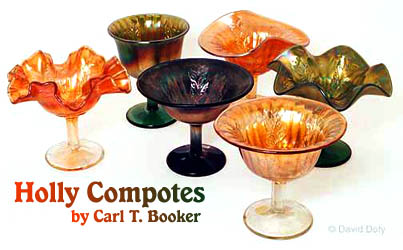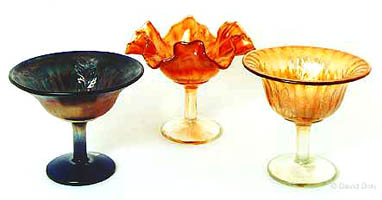By Carl T. Booker
The Holly pattern runs the wide range of items from very common to very rare. This, of course, depends on which Holly pattern is being discussed. Holly patterns were made by Fenton, Millersburg, Dugan, and Northwood (and maybe others). The Holly pattern that Eunice and I collect is the Fenton Holly Compotes (Goblets).
I would be remiss if I didn’t thank (or blame) Mary Helen Yung for stimulating my interest in the Holly Compotes. The Yungs brought their collection for their room display at one of the conventions. It was very interesting and colorful. This started us on our way to searching for these cute little pieces of Carnival Glass.
The Holly Compotes come in an assortment of colors and shapes. The usual shape is the six-ruffled compote. Other shapes that I know of are:
Sides up, goblet shape
Two sides up, two sides down card tray shape
Three-in-one edge
Side up, but lip turned out
Entire piece turned out (a little more would make it a plate)
The color spectrum for Holly Compotes to our knowledge is as follows:
Vaseline
Ice Green with marigold overlay
Amethyst
Light Blue with marigold overlay
Green
Lime Green Opal
Marigold
Cobalt Blue
Aqua
Black
White
Red
Amber
Red Opal
Brown
Pink
I have not seen a pastel Holly compote with pastel iridescence except the white one, but I’m sure they must exist.
What is the appeal of the Holly Compotes? They are available, they come in a variety of shapes and colors, most pieces are not excessively expensive, they don’t take up much display space, and they show the pattern well.
The most expensive Holly Compotes seem to be the Red Opal, Red, Lime Green Opal, and White. We’re sure that a true pastel with pastel iridescence would command a good price, also.



